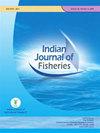Effect of stocking density on the survival and growth of tank-reared Deccan mahseer Tor khudree (Sykes, 1849)
IF 0.3
4区 农林科学
Q4 FISHERIES
引用次数: 0
Abstract
Deccan mahseer, Tor khudree (Sykes, 1849) is the most popular mahseer species of the Western Ghats. However, informationon optimising stocking density for fingerling rearing is not available for T. khudree. A study was undertaken to evaluate theeffect of stocking density on the growth and survival of the blue-fin mahseer, Tor khudree in fry to fingerling rearing. Fishwere reared for 90 days at stocking densities of 15, 25, 35 and 45 fish m-2 in soil-based 24 m2 masonry tanks. The tanks werefertilised initially with cow dung at 3 t ha-1 and were stocked with fry of T. khudree (mean length 1.31±0.09 cm; weight9.49±0.12 mg) after a week of manuring. A mixture (1:1) of powdered groundnut oil cake and rice bran was fed at 10% ofbody weight to the fish during the first month. Subsequently, fish were fed to satiation with a fishmeal-based sinking pelletedfeed (3 mm, 35% crude protein). The length of fish at harvest ranged from 5.03 to 6.43 cm and weight from 1.39 to 3.47 g.The mean final length, weight, specific growth rate and condition factor were the highest (p<0.05) under 15 m-2 and lowestunder 45 m-2 stocking density. The condition factor remained above 1 under all the treatments. No significant (p>0.05)difference in the survival of fish at harvest was recorded. Fish biomass estimates were higher (p<0.05) at higher stockingdensities. The similar (p>0.05) final length and condition factor between the stocking densities of 15, 25 and 35 m-2 and thehighest fish biomass at 35 m-2 indicate a stocking density of 35 fry m-2 as optimal for fry to fingerling rearing of T. khudree. Keywords: Blue-fin mahseer, Peninsular carp, Seed rearing, Stocking density放养密度对池养德干马虎生存和生长的影响(Sykes, 1849)
德干mahseer,Tor khudree(Sykes,1849)是西高止山脉最受欢迎的mahseer物种。然而,关于优化鱼种饲养的放养密度的信息对T.khudree来说是不可用的。研究了放养密度对Tor khudree蓝鳍金枪鱼从鱼苗到鱼种饲养过程中生长和存活的影响。在24平方米的泥土砌石池中,以15、25、35和45条鱼m-2的放养密度饲养鱼类90天。最初用3吨ha-1的牛粪对水槽进行施肥,并在施肥一周后储存t.khudree的鱼苗(平均长度1.31±0.09厘米;重量9.49±0.12毫克)。在第一个月,将花生油饼粉和米糠的混合物(1:1)以10%的体重喂给鱼。随后,用以鱼粉为基础的下沉颗粒饲料(3mm,35%粗蛋白)喂养鱼类以使其饱腹。鱼在收获时的长度为5.03至6.43厘米,重量为1.39至3.47克。平均最终长度、重量、比生长率和条件因子是鱼在收获后存活率的最高差异(p0.05)。鱼类生物量估计值在15、25和35m-2的放养密度之间具有较高的最终长度和条件因子(p0.05),35m-2处的最高鱼类生物量表明35m-2是从鱼苗到鱼种饲养T.khudree的最佳放养密度。关键词:蓝鳍鲤鱼;半岛鲤鱼;种子饲养;放养密度
本文章由计算机程序翻译,如有差异,请以英文原文为准。
求助全文
约1分钟内获得全文
求助全文
来源期刊

Indian Journal of Fisheries
FISHERIES-
CiteScore
0.90
自引率
20.00%
发文量
0
审稿时长
6-12 weeks
期刊介绍:
Indian Journal of Fisheries is published quarterly by the Indian Council of Agricultural Research (ICAR), New Delhi. Original contributions in the field of Fish and fisheries science are considered for publication in the Journal. The material submitted must be unpublished and not under consideration for publication elsewhere.
Papers based on research which kills or damages any species, regarded as thratened/ endangered by IUCN crieteria or is as such listed in the Red Data Book appropriate to the geographic area concerned, will not be accepted by the Journal, unless the work has clear conservation objectives.
 求助内容:
求助内容: 应助结果提醒方式:
应助结果提醒方式:


